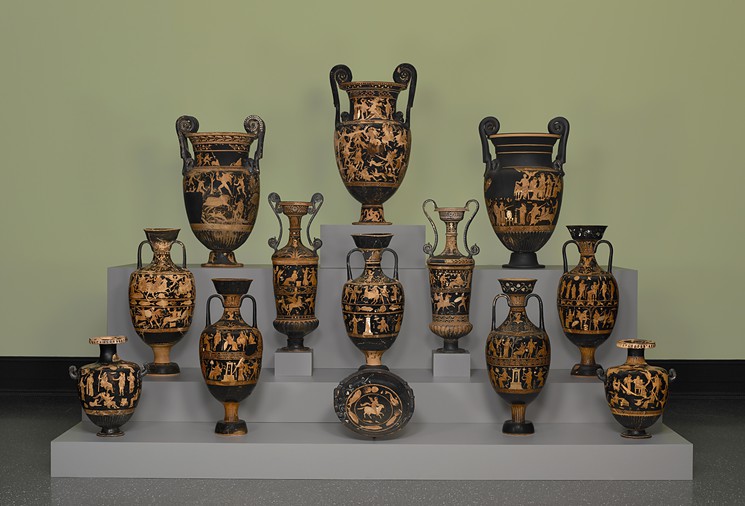VASE LIFT: WHAT ITALIAN ANTIQUITIES TELL US ABOUT CELEBRITY PLASTIC SURGERY
Published in LA WEEKLY
Most people would probably assume that Joan Rivers, Mary Tyler Moore and Funerary Vessel with Judgment of Paris (pictured below) have nothing in common. Other than being crack-ups. And telling stories. And being worth a lot of money. (Mary, if you’re reading this, get the vase’s number and grab a cup off coffee).
But what I was getting at before I started celebrity match-making is that – and I’m whispering this in the most tantalizing of juicy-gossip hushed tones – they’ve all had work done.
“What?! Nooo…”
Oh come on, drop the charade. You can tell. And as far as the Getty’s concerned, that’s a good thing.

Funerary Vessel with Judgment of Paris. Copyright SMB/Antikensammlung, Photo by Johannes Laurentius.
Currently on display at the Getty Villa through May 11, “Dangerous Perfection: Funerary Vases from Southern Italy” makes the case that if something looks suspiciously good for it’s age, it’s, well, suspicious.
This was not the thinking in the 19th century, when Raffaele Gargiulo was a renowned restorer at the Real Museo Borbonico (now the Naples National Archeological Museum) and also a well-known dealer in the Neapolitan market for antiquities. He earned great praise for his work on ceramics, which included the restoration of the thirteen funerary vases from around the fourth century B.C., currently on display at the Getty Villa.
But his interventions — particularly the completion of painted decorations that had been obscured over time — were so effective that it was often difficult to identify what was ancient and what was modern. While this was common practice for the time, there were concerns that this kind of work could be too effective, even deceptive — what one antiquarian described as “dangerous perfection.”
It wasn’t until the Getty used UV illumination, radiography and other advanced techniques that they could confirm what was original and what was 19th century restoration. The goal of a six-year collaborative conservation project between the Getty Villa and the Antikensammlung in Berlin was to re-restore the vases Gargiulo once restored.
Whereas Gargiulo’s approach was largely aesthetic — make the vases look as good as new — Getty conservator Marie Svoboda describes the Getty’s philosophy as honest: “We’re not trying to do something to change the vessel or make them something that they’re not.”
Still, some of the vases — flaking, discolored — did need to be fixed. So, as they made repairs, conservators added modern materials instead of old ones whenever feasible, thereby ensuring the vases’ structural stability.
“In the really aggressive areas on the vessels that we treated here, we filled those because they were so visually disturbing,” Svoboda says. It “needs to be visually appealing.”
One might call this the Christina Applegate, or Angelina Jolie, approach: removing corrupt pieces while reconstructing whatever’s required to maintain the overall shape and appearance — a type of restoration that even the tabloids seem to embrace.

Funerary Vessel with a Dionysian Scene and a Battle between Greeks and Native Italic Warriors; Antikensammlung, Staatliche Museen zu Berlin.
But ultimately, Svoboda says, the goal is that viewers will “recognize what changes were made without being fooled by it. It’s a hard balance to make something look good and visibly understandable.” She wants people to feel like, “I can appreciate it, and yet I know what is original and what is not.” This time, her words brought Madonna and Cher to mind. They’re not one-hundred percent original, but they’re not claiming to be.
Much like Hollywood actresses, the vases are telling a story. Specifically, they depict mythological scenes, drawn from Greek stories and texts, that provide consolation that even the great heroes suffered and that it was possible to prevail over the most frightening of terrors. (Even old age?) But in the restoration process, the question arose of what to do when there were gaps in the story. Gargiulo, the restorer in the 19th century, had guessed at the story and filled in the blanks with his imagination, and then with his paintbrush.
The Getty and Antikensammlung, in their efforts to reconstruct and conserve the vases, agreed not to guess. Most often, they completed losses by filling in the gaps but leaving them undecorated; so where there once may have been a mythological creature, now there is just a neutral color that helps integrate the space with the rest of the surface.

Funerary Vessel with Orestes Seeking Sanctuary at Delphi; Nike Sacrificing a Ram; and a Horse Race; and a Dionysian Scene; a Boar Hunt; and a Horse Race; Antikensammlung, Staatliche Museen zu Berlin.
In certain instances, the Antikensammlung made a bolder choice, leaving the holes in the vases exposed. Theses holes may be visually disturbing, but they allow you to see the vases’ history through their losses. A damaged and exposed vase can still be appreciated and, in allowing it to be, so can its journey. In other words, Berlin gets that, in a movie, we’d prefer to see Jamie Lee Curtis in the role of looks-great-for-her-age grandmother than Madonna.
Of course, each object, as each celebrity, presents its own special case. But the two institutions agreed that the intent of their conservation efforts was to make reconstruction visible. David Saunders, curator of the exhibit and the museum’s associate curator of antiquities, says that in museums these days, “Generally the consensus is that we want to find a balance that allows an ancient object to be appreciated for itself but to allow people to understand that it’s been in some way treated or restored.” Because even when we appreciate something, in ancient art as in Hollywood, what we really want to know is who’s had work done.
“Dangerous Perfection: Funerary Vases from Southern Italy” is on display at the Getty Villa through May 11, 2015.

Discuss - No Comments